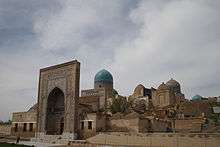Shah-i-Zinda
| Shah-i-Zinda | |
|---|---|
 Shah-i-Zinda in 2007 | |
| Basic information | |
| Location | Samarkand, Uzbekistan |
| Affiliation | Islam |
| Architectural description | |
| Architectural type | Necropolis |
| Architectural style | Timurid |
Shah-i-Zinda (Uzbek: Shohizinda; Persian: شاه زنده, meaning "The Living King") is a necropolis in the north-eastern part of Samarkand, Uzbekistan.
History
The Shah-i-Zinda Ensemble includes mausoleums and other ritual buildings of 9-14th and 19th centuries. The name Shah-i-Zinda (meaning "The living king") is connected with the legend that Kusam ibn Abbas, the cousin of the prophet Muhammad was buried there. As if he came to Samarkand with the Arab invasion in the 7th century to preach Islam. Popular legends speak that he was beheaded for his faith. But he took his head and went into the deep well (Garden of Paradise), where he's still living now.
The Shah-i-Zinda complex was formed over nine (from 11th till 19th) centuries and now includes more than twenty buildings.
The ensemble comprises three groups of structures: lower, middle and upper connected by four-arched domed passages locally called chartak. The earliest buildings date back to the 11-12th centuries. Mainly their bases and headstones have remained now. The most part dates back to the 14-15th centuries. Reconstructions of the 16-19th centuries were of no significance and did not change the general composition and appearance.[1]
The initial main body - Kusam-ibn-Abbas complex - is situated in the northeastern part of the ensemble. It consists of several buildings. The most ancient of them, the Kusam-ibn-Abbas mausoleum and mosque (16th century), are among them.[2]
The upper group of buildings consists of three mausoleums facing each other. The earliest one is Khodja-Akhmad Mausoleum (1340s), which completes the passage from the north. The Mausoleum of 1361, on the right, restricts the same passage from the east.[3][4][5]
The middle group consists of the mausoleums of the last quarter of the 14th century - first half of the 15th century and is concerned with the names of Timur's relatives, military and clergy aristocracy. On the western side the Mausoleum of Shadi Mulk Aga, the niece of Timur, stands out. This portal-domed one-premise crypt was built in 1372. Opposite is the Mausoleum of Shirin Bika Aga, Timur's sister.[6][7][8]
Next to Shirin-Bika-Aga Mausoleum is the so-called Octahedron, an unusual crypt of the first half of the 15th century.[9]
Near the multi-step staircase the most well proportioned buildings of the lower group is situated. It is a double-cupola mausoleum of the beginning of the 15th century. This mausoleum is devoted to Kazi Zade Rumi, who was the scientist and astronomer. Therefore the double-cupola mausoleum which was built by Ulugbek above his tomb in 1434-1435th has the height comparable with cupolas of the royal family's mausoleums.[10]
The main entrance gate to the ensemble (Darvazakhana or the first chartak) turned southward was built in 1434-1435 under Ulugbek.[11]
Read also
References
External links
Coordinates: 39°39′47″N 66°59′16″E / 39.66306°N 66.98778°E
| Wikimedia Commons has media related to Shah-i-Zinda. |